Back to school: Teaching the User Experience Design process
Ryan Hope
User Experience Designer
Tagged with:
Hello, I’m a User Experience Designer in �������� Future Media. I’m delighted to write my first �������� blog post and tell you about a really exciting collaboration that happened earlier this year between �������� User Experience & Design (UX&D) and the .
With two UX&D colleagues, senior designer Rae Spencer and user experience architect Dan Ramsden, we devised and delivered a ten-week module for second year students on the BA (Hons) Creative Multimedia course - the School of Art’s newest degree programme. We are really keen to take this opportunity to share with you what we did and why we look forward to continuing this again in the future.
We kicked off the course in January with a workshop, inviting students to meet us at our �������� offices in to introduce and welcome them to User Experience and Design at the ��������. This introductory workshop featured a series of short, 5 minute “lightning talks”. The talks gave an overview of the rich scope of UX at the ��������, each given by a different grade (trainee to creative director) and a unique role (designers, information architects and researchers) from across our diverse areas (,��, , and so on.)
We were eager for this first interaction to be as friendly, stimulating and fun as possible. We combined the talks with engaging practical activities, highlighting and key aspects of UX design such as understanding user needs and rapid prototyping to offer an exciting taste of what to expect in the upcoming weeks.
So began the course in earnest. The second week was another week of firsts; Our first class to the students, the students’ first class from us and above all the first week working on the project. We introduced the brief, which we based closely on an existing live project exploring personalisation and signed-in experience from the ��������.
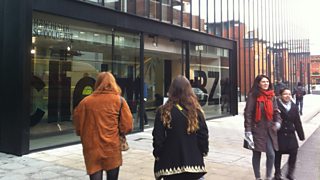
Bright and early for our first class.
We structured the course around our ; Understand, Diverge, Converge, Prototype and Test. This was adapted to fit over ten weekly sessions, each had a specific topic/theme, which we introduced, demonstrated and then assigned as the focus for the students’ ongoing project that week.
As well as following our professional process for designing user experiences it was really important that the students adopt some of our professional practices too. We were fortunate that the School of Art was able to allocate a room exclusively for the project. This meant that, as well as always knowing exactly where we were meant to be at 10 a.m. each Tuesday there was a permanent accessible space where the students could work and stick their work up on the walls.
Visibility is an important part of how we work in UX&D. Being able to see what each other is working on is a great motivator and initiator of communication and interaction with peers. Often this leads to new ideas, identifying and solving issues before they become problems and of course, celebrating endeavor and success. Without knowing the students individually this was initially a valuable way for us to get a sense of each student’s interests, strengths and ways of working. Then, as the course progressed, it was a great way for us to see the individual development of each student’s project.
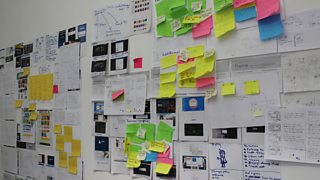
Reflection and collaboration as students share their thinking and progress on the wall.
Another part of our regular practice that we introduced the students to was weekly Standups. These were short informal presentations that involved each student talking through their projects progress alongside their work on the wall. This proved a great way of encouraging the students to open up and gain confidence in the early stages of the project and for us to keep in touch with progress between classes.
Confidence can have such a profound effect on learning. We worked hard to create a friendly atmosphere and environment throughout the course where students could freely experiment and explore the techniques and topics we were introducing. We had a strong appreciation of vulnerability – that there’s a fine line between being the expert and being intimidating. From the first few weeks we sought to show that as “lecturers” we were there to learn too, that we were human too. This had great value in building a supportive and positive environment.
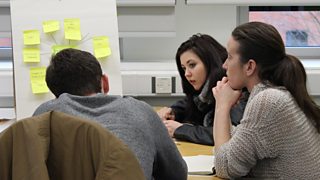
Giving feedback.
In our feedback we focused on encouraging thinking and questioning. We weren’t focused solely on the ideas or answers that the students gave, but on the process they used to get there. We’d create connections between what they’d done in the past and what others in the class were doing. We’d got a picture of what they knew and cared about, so we could build on that. We used a range and blend of teaching techniques - experiential, co-operative, differentiation and relating theory to practice.
Throughout the ten weeks we really wanted to get the students to understand that great ideas are born from research and understanding of the audience. After a week of detailed research around a specific the fourth week explored the power of storytelling both as a design facilitation tool and also as a means of getting your stakeholders onboard. We also spent this session introducing the technique of generating “How might we questions” as a means of defining potential design goals. This week acted as the springboard for the most creative stage of the project.
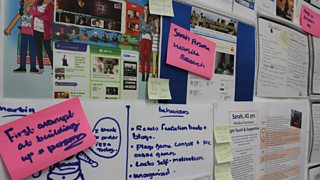
Exploring user stories around personas to build empathy and define user needs.
After the students generated a variety of design solutions we held a Dot Vote. In dot voting each member of the team gets a number of sticky dots. They use the dots to vote for the idea(s) they think have the most potential. This stage was about setting expectations and introducing some ambition and reality. We wanted the best ideas possible and also for them to appreciate the amount of thought to get from an idea into a prototype.
Usability testing prototypes is a fundamental way we validate our designs in UX&D, and so we integrated this as a key part of the course. We’d emphasized to the students the value of testing our designs, in particular the value of identifying areas to improve and how in the test identifying weaknesses in a design was a great positive. Asking the students to build a prototype and prepare for a usability test in just two weeks seemed a real challenge. Add to that this was their first experience of testing their work with real people and the fact they would be running the research sessions at our state of the art �������� lab in MediaCityUK and the challenge we were asking the students to rise to seemed even greater.
While each student facilitated the testing of their design the other students supported them by observing the sessions and noting what worked well, not so well and recording other findings. We ran the sessions over full days, two in fact to fit everyone in.
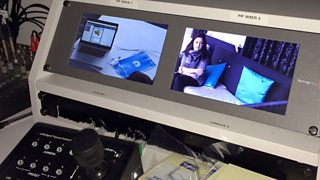
Testing prototypes in our R&D Usability Lab.
For both the students and us the usability testing was a huge success and became a highlight of the ten-week course. Every student rose to the challenge brilliantly, found the feedback from users insightful and even the most initially apprehensive student did a wonderful job and visibly grew in confidence. It was truly rewarding for all.
Following the usability test students reflected on the notes and findings and prepared to return to us at the �������� to give a final presentation appraising their project and the process they had followed.
I mentioned at the beginning of this blog post that we devised and were delivering the course for the very first time; the course itself was a prototype, which we iterated as we went along. So true to form having tested our prototype we thought it best to collect our results and gather feedback. We spent our last week at MMU working with the students and their course leader to envisage what the dream course would be next year. We collected what we learnt and gained great insights into how we, or any member of the �������� design team, could work better with the lecturers and the students in the future.
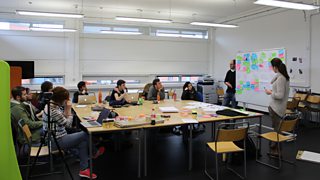
Reflecting and evaluating the 10-week course.
The ten-week course was a real success. The insight and motivation gained from working with the �������� has seen one of the students go on and join our 12-week summer placement scheme, which he recently completed within the UX team in �������� Sport.
As well as benefits to the students, running the course offers great opportunities for us as designers to practice our leadership skills, share our enthusiasm and support the development of others. We really hope that this shared supportive and rewarding experience is one MMU and the �������� will benefit from years to come.
If you are interested in the summer placement scheme at the �������� and would like more information please leave a comment and we’ll be in touch.
Ryan Hope is a User Experience Designer, �������� Future Media.
